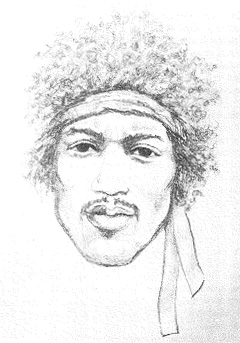
Monterey Pop
It wasn't until I heard The Beatles' album Revolver that I started liking their music. A friend phoned when the Mop Tops were appearing on the Ed Sullivan Show, and said, “Wait till you see these guys. They're wonderful!” What I saw was four guys in their twenties wearing matching cute outfits with matching cute hairdos, singing a too-cute song, “I Wanna Hold Your Hand.” If I had been twelve years old, they might have been impressive.
At the time, my idea of rock and roll was The Rolling Stones—craggy wiseguys playing flat-out rock with seriously offensive lyrics, each of them making their own decisions about what to wear and how to look. I loved how Jagger defied his audience to join in the fun. The women who were my contemporaries were either folk sopranos or blues singers, categories that didn't fit Yours Truly. Jagger's bad-boy-with-attitude persona was something I understood. I didn't copy his singing style or mannerisms, but, from watching him perform and listening to his music, I learned how to let it out and damn the censorship. Jagger and The Stones were the only element I missed at the Monterey Pop Festival.
The rest of it was perfect.
Outdoor concerts are common now, but when Monterey Pop happened, I'd never seen anything like it. Produced by Lou Adler and The Mamas and the Papas, it's the only festival I can think of that was excellent in every way.
It was June 1967. In the beautiful setting of the Carmel coast, the audience area was on a large, grassy lawn surrounded by cypress and pine trees. Unlike most summer concerts where the sun shone down mercilessly, here the big tree branches broke up the light into soft beams, making everything look like a Disney version of Sherwood Forest. In back of the trees, around the perimeter of the seating space, were about thirty small booths, individually decorated with colored silks and cottons and hand-painted banners, showing off every kind of original creation—from one-of-a-kind boots and belts to framed paintings by amateur artists. Even the stalls selling food and concert items were quaint and uninfected by corporate logos and pitchmen.

“Jimi Hendrix” (Grace Slick)
I had previously heard most of the musicians at Monterey Pop on record, but I had never actually seen them live, from Otis Redding to Ravi Shankar. The lineup boasted an all-inclusive representation of “new” music. Black, white, East, West, rock, blues, instrumental, pop, and folk—the three-day list of performers was made up of nothing but head-liners. You may have seen some of the performances in the film Monterey Pop on VH1 or MTV. One clip of Jefferson Airplane has the camera on Yours Truly, mouthing the lyrics of the song “Today,” but it was Marty's song and his voice on the soundtrack. Since I knew his phrasing, I used to just sing along while I was playing the piano, and the engineer, who knew my habits, would turn my mike off. But in the film, my lips match Marty's vocals perfectly, and it appears I'm the one singing. Twenty-five years ago, Marty probably wasn't too happy that no one caught the editing mistake and that my lip synching appeared in the final film version, but I'm sure he finds it mildly amusing now.
“Nobody had ever heard anything like it.” That was John Phillips talking about Jimi Hendrix's performance at Monterey. I watched him play the guitar with his teeth, use the mike stand for slide guitar, bang into the speakers for feedback, and finally set his guitar on fire with lighter fluid. None of the theatrics could overshadow his incredible musicianship. And the fabulous outfit! He wore a perfect sixties costume: Spanish hat, Mongol vest, ostrich boa, English velvet pants, silk ruffled paisley shirt, pounds of handmade jewelry, and Western boots. If any musician represented that era, it was Jimi Hendrix.
At Monterey Pop, within seventy-two hours, you could see The Who, Buffalo Springfield, The Dead, The Mamas and the Papas, Country Joe and the Fish, Big Brother with Janis Joplin, Jimi Hendrix, Laura Nyro, Ravi Shankar, Quicksilver Messenger Service, Simon and Garfunkel, Paul Butterfield, Otis Redding, Jefferson Airplane, and the band that wrote the song about it (“Monterey”), The Animals.
We all combined to create a peaceful and extraordinary offering (even the police cruisers had orchids on their antennas). And I felt lucky to be there, observing one of the great examples of human celebration.